外文翻译---建筑物的组成及高层结构
- 格式:doc
- 大小:72.50 KB
- 文档页数:10
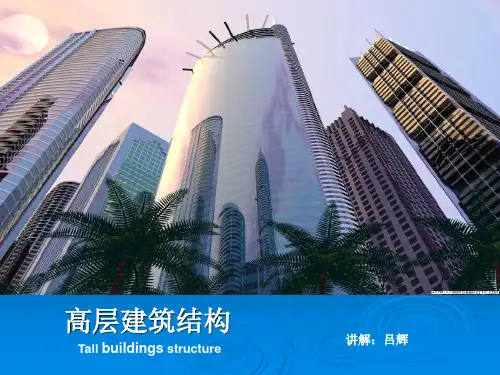
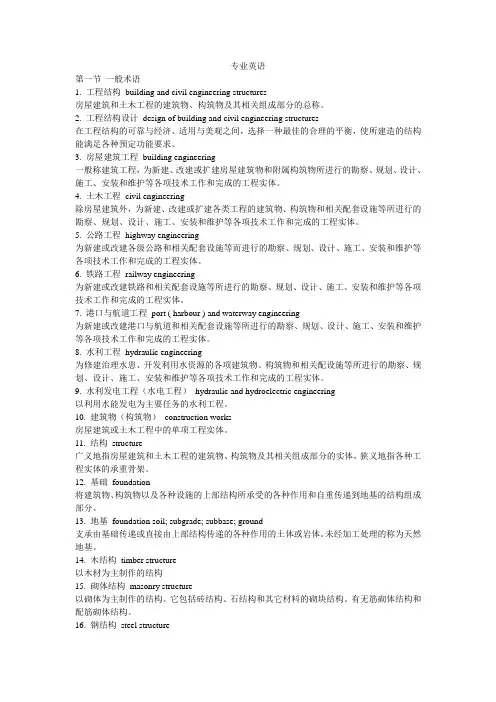
专业英语第一节一般术语1. 工程结构building and civil engineering structures房屋建筑和土木工程的建筑物、构筑物及其相关组成部分的总称。
2. 工程结构设计design of building and civil engineering structures在工程结构的可靠与经济、适用与美观之间,选择一种最佳的合理的平衡,使所建造的结构能满足各种预定功能要求。
3. 房屋建筑工程building engineering一般称建筑工程,为新建、改建或扩建房屋建筑物和附属构筑物所进行的勘察、规划、设计、施工、安装和维护等各项技术工作和完成的工程实体。
4. 土木工程civil engineering除房屋建筑外,为新建、改建或扩建各类工程的建筑物、构筑物和相关配套设施等所进行的勘察、规划、设计、施工、安装和维护等各项技术工作和完成的工程实体。
5. 公路工程highway engineering为新建或改建各级公路和相关配套设施等而进行的勘察、规划、设计、施工、安装和维护等各项技术工作和完成的工程实体。
6. 铁路工程railway engineering为新建或改建铁路和相关配套设施等所进行的勘察、规划、设计、施工、安装和维护等各项技术工作和完成的工程实体。
7. 港口与航道工程port ( harbour ) and waterway engineering为新建或改建港口与航道和相关配套设施等所进行的勘察、规划、设计、施工、安装和维护等各项技术工作和完成的工程实体。
8. 水利工程hydraulic engineering为修建治理水患、开发利用水资源的各项建筑物、构筑物和相关配设施等所进行的勘察、规划、设计、施工、安装和维护等各项技术工作和完成的工程实体。
9. 水利发电工程(水电工程)hydraulic and hydroelectric engineering以利用水能发电为主要任务的水利工程。
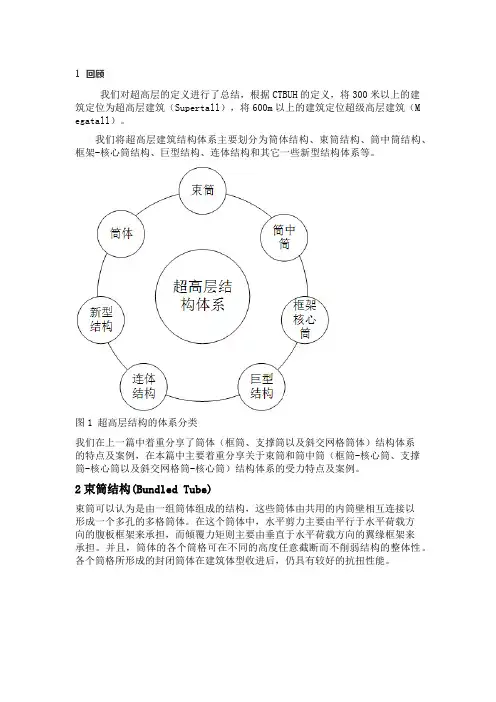
1 回顾我们对超高层的定义进行了总结,根据CTBUH的定义,将300米以上的建筑定位为超高层建筑(Supertall),将600m以上的建筑定位超级高层建筑(M egatall)。
我们将超高层建筑结构体系主要划分为筒体结构、束筒结构、筒中筒结构、框架-核心筒结构、巨型结构、连体结构和其它一些新型结构体系等。
图1 超高层结构的体系分类我们在上一篇中着重分享了筒体(框筒、支撑筒以及斜交网格筒体)结构体系的特点及案例,在本篇中主要着重分享关于束筒和筒中筒(框筒-核心筒、支撑筒-核心筒以及斜交网格筒-核心筒)结构体系的受力特点及案例。
2束筒结构(Bundled Tube)束筒可以认为是由一组筒体组成的结构,这些筒体由共用的内筒壁相互连接以形成一个多孔的多格筒体。
在这个筒体中,水平剪力主要由平行于水平荷载方向的腹板框架来承担,而倾覆力矩则主要由垂直于水平荷载方向的翼缘框架来承担。
并且,筒体的各个筒格可在不同的高度任意截断而不削弱结构的整体性。
各个筒格所形成的封闭筒体在建筑体型收进后,仍具有较好的抗扭性能。
图2 由半圆筒体和矩形筒体组成的束筒结构束筒是在框筒的基础上发展而来。
对于框筒结构,由于剪力滞后的负面影响,较大的平面尺寸中间位置的结构不能充分参与到结构抗侧中去,这也是限制框筒结构适用高度的一个主要原因。
如果利用框筒结构来设计更高的超高层建筑,可能需要采用更小的柱距来减小剪力滞后的不利影响,例如410m高的纽约世贸中心双子塔的柱距达到了惊人的1m左右,即使这么小的柱距依然呈现出明显的剪力滞后效应。
图3 世贸中心双子塔框筒的剪力滞后效应提出筒体结构体系的Fazlur博士在指导学生的论文时发现,如果利用通长的剪力墙将框筒长边一分为三时,由于隔板剪力墙的协同作用,大尺寸筒体的剪力滞后效应明显降低了,其抗侧刚度也可以得到大幅提升。
图4 束筒结构的原型如果横隔剪力墙可以有效降低长边的剪力滞后效应,那么对于大尺寸的框筒结构,在两个方向都引入横隔剪力墙,必然可以提高大尺寸框筒的整体空间作用。
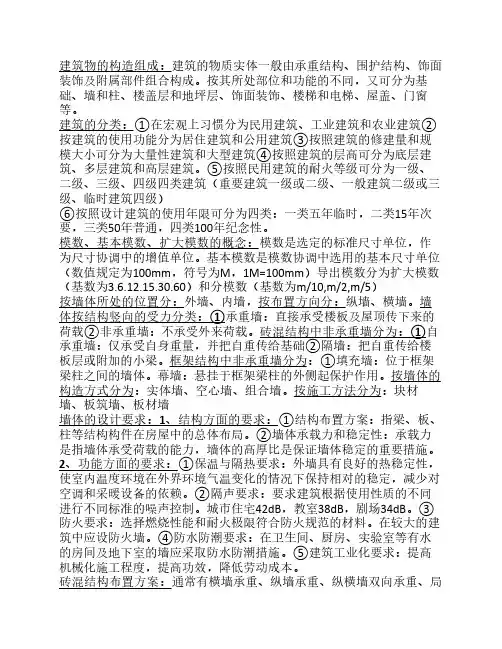
建筑物的构造组成:建筑的物质实体一般由承重结构、围护结构、饰面装饰及附属部件组合构成。
按其所处部位和功能的不同,又可分为基础、墙和柱、楼盖层和地坪层、饰面装饰、楼梯和电梯、屋盖、门窗等。
建筑的分类:①在宏观上习惯分为民用建筑、工业建筑和农业建筑②按建筑的使用功能分为居住建筑和公用建筑③按照建筑的修建量和规模大小可分为大量性建筑和大型建筑④按照建筑的层高可分为底层建筑、多层建筑和高层建筑。
⑤按照民用建筑的耐火等级可分为一级、二级、三级、四级四类建筑(重要建筑一级或二级、一般建筑二级或三级、临时建筑四级)⑥按照设计建筑的使用年限可分为四类:一类五年临时,二类15年次要,三类50年普通,四类100年纪念性。
模数、基本模数、扩大模数的概念:模数是选定的标准尺寸单位,作为尺寸协调中的增值单位。
基本模数是模数协调中选用的基本尺寸单位(数值规定为100mm,符号为M,1M=100mm)导出模数分为扩大模数(基数为3.6.12.15.30.60)和分模数(基数为m/10,m/2,m/5)按墙体所处的位置分:外墙、内墙,按布置方向分:纵墙、横墙。
墙体按结构竖向的受力分类:①承重墙:直接承受楼板及屋顶传下来的荷载②非承重墙:不承受外来荷载。
砖混结构中非承重墙分为:①自承重墙:仅承受自身重量,并把自重传给基础②隔墙:把自重传给楼板层或附加的小梁。
框架结构中非承重墙分为:①填充墙:位于框架梁柱之间的墙体。
幕墙:悬挂于框架梁柱的外侧起保护作用。
按墙体的构造方式分为:实体墙、空心墙、组合墙。
按施工方法分为:块材墙、板筑墙、板材墙墙体的设计要求:1、结构方面的要求:①结构布置方案:指梁、板、柱等结构构件在房屋中的总体布局。
②墙体承载力和稳定性:承载力是指墙体承受荷载的能力,墙体的高厚比是保证墙体稳定的重要措施。
2、功能方面的要求:①保温与隔热要求:外墙具有良好的热稳定性,使室内温度环境在外界环境气温变化的情况下保持相对的稳定,减少对空调和采暖设备的依赖。
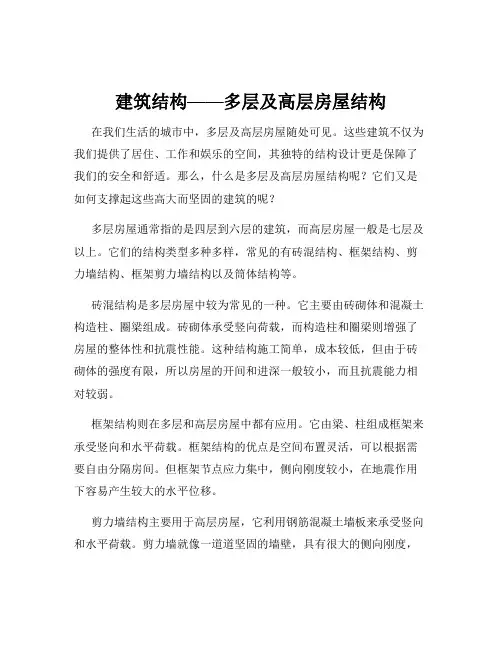
建筑结构——多层及高层房屋结构在我们生活的城市中,多层及高层房屋随处可见。
这些建筑不仅为我们提供了居住、工作和娱乐的空间,其独特的结构设计更是保障了我们的安全和舒适。
那么,什么是多层及高层房屋结构呢?它们又是如何支撑起这些高大而坚固的建筑的呢?多层房屋通常指的是四层到六层的建筑,而高层房屋一般是七层及以上。
它们的结构类型多种多样,常见的有砖混结构、框架结构、剪力墙结构、框架剪力墙结构以及筒体结构等。
砖混结构是多层房屋中较为常见的一种。
它主要由砖砌体和混凝土构造柱、圈梁组成。
砖砌体承受竖向荷载,而构造柱和圈梁则增强了房屋的整体性和抗震性能。
这种结构施工简单,成本较低,但由于砖砌体的强度有限,所以房屋的开间和进深一般较小,而且抗震能力相对较弱。
框架结构则在多层和高层房屋中都有应用。
它由梁、柱组成框架来承受竖向和水平荷载。
框架结构的优点是空间布置灵活,可以根据需要自由分隔房间。
但框架节点应力集中,侧向刚度较小,在地震作用下容易产生较大的水平位移。
剪力墙结构主要用于高层房屋,它利用钢筋混凝土墙板来承受竖向和水平荷载。
剪力墙就像一道道坚固的墙壁,具有很大的侧向刚度,能够有效地抵抗水平荷载,如风力和地震力。
不过,剪力墙结构的空间布置相对不够灵活。
框架剪力墙结构结合了框架结构和剪力墙结构的优点。
在框架结构中布置一定数量的剪力墙,既保证了空间的灵活性,又提高了结构的抗侧力能力。
这种结构在高层房屋中应用广泛,能够适应不同的建筑功能和造型要求。
筒体结构是一种更加高效的结构形式,适用于超高层建筑。
它可以分为框筒结构、筒中筒结构和束筒结构等。
筒体结构具有极大的侧向刚度和承载力,能够有效地抵抗风荷载和地震作用。
在多层及高层房屋的结构设计中,荷载的考虑至关重要。
竖向荷载包括房屋自身的重量、家具设备的重量以及人员的重量等。
而水平荷载,如风力和地震力,对于高层房屋的影响更为显著。
为了抵抗水平荷载,结构需要具备足够的侧向刚度和抗震能力。

高层建筑的四大结构体系目前国内高层建筑的四大结构体系:框架结构、剪力墙结构、框架剪力墙结构和筒体结构。
一、框架结构体系:框架结构体系是由楼板、梁、柱及基础四种承重构件组成。
由梁、柱、基础构成平面框架,它是主要承重结构,各平面框架再由连系梁连系起来,即形成一个空间结构体系,它是高层建筑中常用的结构形式之一。
一般用于钢结构和钢筋混凝土结构中,由梁和柱通过节点构成承载结构,框架形成可灵活布置的建筑空间,使用较方便。
钢筋混凝土框架按施工方法的不同。
又可分为:①梁、板、柱全部现场浇筑的全现浇框架;②楼板预制,梁、柱现场浇筑的部分现浇框架;③梁、板预制,柱现场浇筑的半装配式框架;④梁、板、柱全部预制的全装配式框架。
优点:建筑平面布置灵活,能获得大空间,建筑立面也容易处理,结构自重轻,计算理论也比较成熟,在一定高度范围内造价较低。
缺点:框架结构本身柔性较大,抗侧力能力较差,在风荷载作用下会产生较大的水平位移,在地震荷载作用下,非结构构件破坏比较严重。
适用范围:框架结构的合理层数一般是6到15层,最经济的层数是10层左右。
由于框架结构能提供较大的建筑空间,平面布置灵活,可适合多种工艺与使用的要求,已广泛应用于办公、住宅、商店、医院、旅馆、学校及多层工业厂房和仓库中。
二、剪力墙结构体系在高层建筑中为了提高房屋结构的抗侧力刚度,在其中设置的钢筋混凝土墙体称为“剪力墙”,剪力墙的主要作用在于提高整个房屋的抗剪强度和刚度,墙体同时也作为维护及房间分隔构件。
优点:由钢筋混凝土墙体承受全部水平和竖向荷载,剪力墙沿横向纵向正交布置或沿多轴线斜交布置,它刚度大,空间整体性好,用钢量省。
历史地震中,剪力墙结构表现了良好的抗震性能,震害较少发生,而且程度也较轻微,在住宅和旅馆客房中采用剪力墙结构可以较好地适应墙体较多、房间面积不太大的特点,而且可以使房间不露梁柱,整齐美观。
缺点:剪力墙结构墙体较多,不容易布置面积较大的房间,为了满足旅馆布置门厅、餐厅、会议室等大面积公共用房的要求,以及在住宅楼底层布置商店和公共设施的要求,可以将部分底层或部分层取消剪力墙代之以框架,形成框支剪力墙结构。

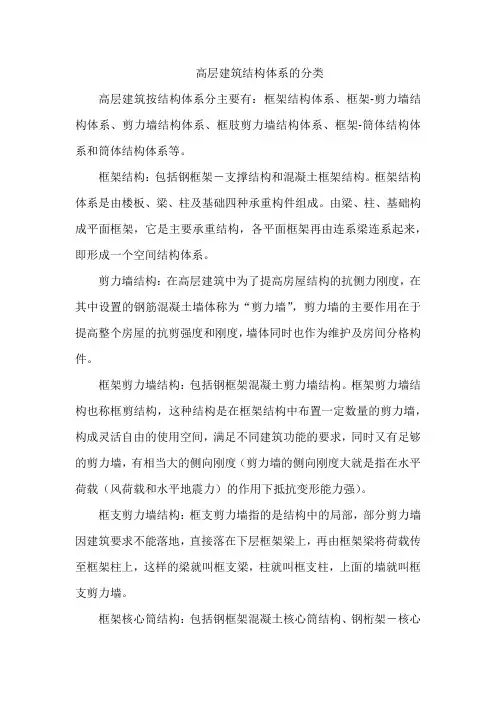
高层建筑结构体系的分类
高层建筑按结构体系分主要有:框架结构体系、框架-剪力墙结构体系、剪力墙结构体系、框肢剪力墙结构体系、框架-筒体结构体系和筒体结构体系等。
框架结构:包括钢框架-支撑结构和混凝土框架结构。
框架结构体系是由楼板、梁、柱及基础四种承重构件组成。
由梁、柱、基础构成平面框架,它是主要承重结构,各平面框架再由连系梁连系起来,即形成一个空间结构体系。
剪力墙结构:在高层建筑中为了提高房屋结构的抗侧力刚度,在其中设置的钢筋混凝土墙体称为“剪力墙”,剪力墙的主要作用在于提高整个房屋的抗剪强度和刚度,墙体同时也作为维护及房间分格构件。
框架剪力墙结构:包括钢框架混凝土剪力墙结构。
框架剪力墙结构也称框剪结构,这种结构是在框架结构中布置一定数量的剪力墙,构成灵活自由的使用空间,满足不同建筑功能的要求,同时又有足够的剪力墙,有相当大的侧向刚度(剪力墙的侧向刚度大就是指在水平荷载(风荷载和水平地震力)的作用下抵抗变形能力强)。
框支剪力墙结构:框支剪力墙指的是结构中的局部,部分剪力墙因建筑要求不能落地,直接落在下层框架梁上,再由框架梁将荷载传至框架柱上,这样的梁就叫框支梁,柱就叫框支柱,上面的墙就叫框支剪力墙。
框架核心筒结构:包括钢框架混凝土核心筒结构、钢桁架-核心
筒结构、筒中筒钢结构、束筒钢结构。
由密柱高梁空间框架或空间剪力墙所组成,在水平荷载作用下起整体空间作用的抗侧力构件称为筒体,由密柱框架组成的筒体称为框筒,由剪力墙组成的筒体称为薄壁筒。
一般适用于它适用于平面或竖向布置繁杂、水平荷载大30-50层高层建筑。
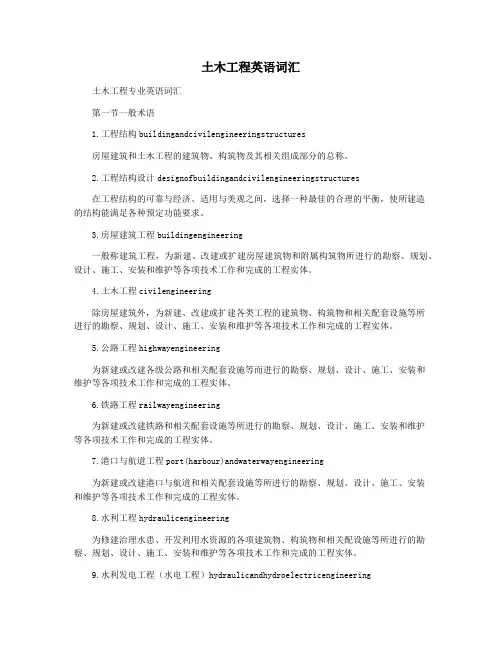
土木工程英语词汇土木工程专业英语词汇第一节一般术语1.工程结构buildingandcivilengineeringstructures房屋建筑和土木工程的建筑物、构筑物及其相关组成部分的总称。
2.工程结构设计designofbuildingandcivilengineeringstructures在工程结构的可靠与经济、适用与美观之间,选择一种最佳的合理的平衡,使所建造的结构能满足各种预定功能要求。
3.房屋建筑工程buildingengineering一般称建筑工程,为新建、改建或扩建房屋建筑物和附属构筑物所进行的勘察、规划、设计、施工、安装和维护等各项技术工作和完成的工程实体。
4.土木工程civilengineering除房屋建筑外,为新建、改建或扩建各类工程的建筑物、构筑物和相关配套设施等所进行的勘察、规划、设计、施工、安装和维护等各项技术工作和完成的工程实体。
5.公路工程highwayengineering为新建或改建各级公路和相关配套设施等而进行的勘察、规划、设计、施工、安装和维护等各项技术工作和完成的工程实体。
6.铁路工程railwayengineering为新建或改建铁路和相关配套设施等所进行的勘察、规划、设计、施工、安装和维护等各项技术工作和完成的工程实体。
7.港口与航道工程port(harbour)andwaterwayengineering为新建或改建港口与航道和相关配套设施等所进行的勘察、规划、设计、施工、安装和维护等各项技术工作和完成的工程实体。
8.水利工程hydraulicengineering为修建治理水患、开发利用水资源的各项建筑物、构筑物和相关配设施等所进行的勘察、规划、设计、施工、安装和维护等各项技术工作和完成的工程实体。
9.水利发电工程(水电工程)hydraulicandhydroelectricengineering以利用水能发电为主要任务的水利工程。
10.建筑物(构筑物)constructionworks房屋建筑或土木工程中的单项工程实体。
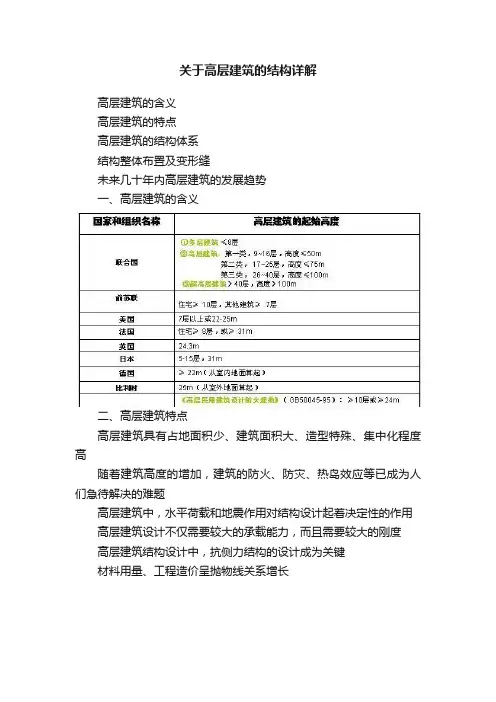
关于高层建筑的结构详解高层建筑的含义高层建筑的特点高层建筑的结构体系结构整体布置及变形缝未来几十年内高层建筑的发展趋势一、高层建筑的含义二、高层建筑特点高层建筑具有占地面积少、建筑面积大、造型特殊、集中化程度高随着建筑高度的增加,建筑的防火、防灾、热岛效应等已成为人们急待解决的难题高层建筑中,水平荷载和地震作用对结构设计起着决定性的作用高层建筑设计不仅需要较大的承载能力,而且需要较大的刚度高层建筑结构设计中,抗侧力结构的设计成为关键材料用量、工程造价呈抛物线关系增长三、高层建筑结构的发展状况1、我国古代高层建筑的发展公元524年在河南建造了嵩岳寺塔(15层简筒结构,高50m)公元704年在西安建造了大雁塔(7层砖木结构,总高64m)公元1055年在河北定县建造了料敌塔(11层筒体结构,高82m) 公元1056年山西建造了应县木塔(9层,高67m),堪称世界木结构的奇迹高层建筑是近代经济发展和科学技术进步的产物,至今已有100余年的历史。
多年来,世界上最高的高层建筑集中在美国、加拿大,直到80年代末,北美洲一直是世界高层建筑的中心。
按1991年公布的排行表,在世界上最高的100座最高建筑中,美国占了78座,加拿大5座,墨西哥1座,即北美洲占了84%,成了当前世界最高建筑的中心2、我国近代高层建筑的发展第一阶段:从新中国成立到60年代末初步发展,20层以下的框架结构:1959年建成的北京民族饭店(12层,高47.4m)1964年建成了北京民航大楼,(15层,高60.8m)1966年建成了广州人民大厦(18层,高63m)第二阶段:70年代20—30层,主要用于住宅、旅馆、办公楼1974年建成的北京饭店新楼:20层,高87.4m,是当时北京最高的建筑;1976年建成的广州白云宾馆:33层、高114.05m;上海漕溪路20幢12 16层剪力墙住宅楼;北京前三门40幢9 16层大模板施工的剪力墙住宅楼。
北京饭店新楼广州白云宾馆33层,112.45米,剪力墙结构,1976年建成,国内首栋百米高层。
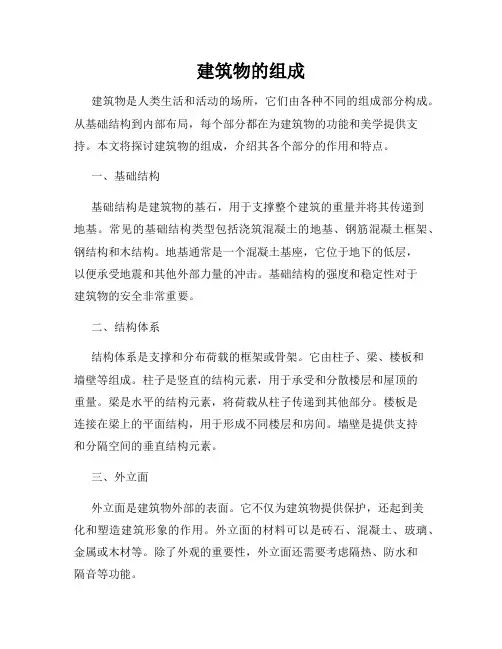
建筑物的组成建筑物是人类生活和活动的场所,它们由各种不同的组成部分构成。
从基础结构到内部布局,每个部分都在为建筑物的功能和美学提供支持。
本文将探讨建筑物的组成,介绍其各个部分的作用和特点。
一、基础结构基础结构是建筑物的基石,用于支撑整个建筑的重量并将其传递到地基。
常见的基础结构类型包括浇筑混凝土的地基、钢筋混凝土框架、钢结构和木结构。
地基通常是一个混凝土基座,它位于地下的低层,以便承受地震和其他外部力量的冲击。
基础结构的强度和稳定性对于建筑物的安全非常重要。
二、结构体系结构体系是支撑和分布荷载的框架或骨架。
它由柱子、梁、楼板和墙壁等组成。
柱子是竖直的结构元素,用于承受和分散楼层和屋顶的重量。
梁是水平的结构元素,将荷载从柱子传递到其他部分。
楼板是连接在梁上的平面结构,用于形成不同楼层和房间。
墙壁是提供支持和分隔空间的垂直结构元素。
三、外立面外立面是建筑物外部的表面。
它不仅为建筑物提供保护,还起到美化和塑造建筑形象的作用。
外立面的材料可以是砖石、混凝土、玻璃、金属或木材等。
除了外观的重要性,外立面还需要考虑隔热、防水和隔音等功能。
四、屋顶屋顶是建筑物的顶部覆盖物,用于提供保护和防水功能。
它可以是平屋顶、坡屋顶、弯曲屋顶或复杂的屋顶景观。
屋顶材料可以是瓦片、金属、沥青卷材或橡胶等。
不同的屋顶设计和材料选择可以帮助建筑物在不同气候条件下保持舒适和安全。
五、内部布局内部布局包括房间划分、门窗位置、电气系统、管道系统和空调系统等。
它需要根据建筑物的功能和需求进行合理的规划和设计。
内部布局需要考虑通风、采光、安全性和人体工程学等方面。
六、装饰与装修建筑物的装饰与装修是为了增加美感和个性化。
它可以包括墙壁色彩、地板材料、照明设备、家具和艺术品等。
装饰与装修使建筑物与周围环境相协调,并满足居住者的审美需求。
总结:建筑物的组成包括基础结构、结构体系、外立面、屋顶、内部布局和装饰与装修。
这些组成部分相互配合,为建筑物提供结构支持、保护功能和美学价值。
土木工程专业英语词汇第一节一般术语1. 工程结构building and civil engineering structures房屋建筑和土木工程的建筑物、构筑物及其相关组成部分的总称。
2. 工程结构设计design of building and civil engineering structures在工程结构的可靠与经济、适用与美观之间,选择一种最佳的合理的平衡,使所建造的结构能满足各种预定功能要求。
3. 房屋建筑工程building engineering一般称建筑工程,为新建、改建或扩建房屋建筑物和附属构筑物所进行的勘察、规划、设计、施工、安装和维护等各项技术工作和完成的工程实体。
4. 土木工程civil engineering除房屋建筑外,为新建、改建或扩建各类工程的建筑物、构筑物和相关配套设施等所进行的勘察、规划、设计、施工、安装和维护等各项技术工作和完成的工程实体。
5. 公路工程highway engineering为新建或改建各级公路和相关配套设施等而进行的勘察、规划、设计、施工、安装和维护等各项技术工作和完成的工程实体。
6. 铁路工程railway engineering为新建或改建铁路和相关配套设施等所进行的勘察、规划、设计、施工、安装和维护等各项技术工作和完成的工程实体。
7. 港口与航道工程port ( harbour ) and waterway engineering为新建或改建港口与航道和相关配套设施等所进行的勘察、规划、设计、施工、安装和维护等各项技术工作和完成的工程实体。
8. 水利工程hydraulic engineering为修建治理水患、开发利用水资源的各项建筑物、构筑物和相关配设施等所进行的勘察、规划、设计、施工、安装和维护等各项技术工作和完成的工程实体。
9. 水利发电工程(水电工程)hydraulic and hydroelectric engineering以利用水能发电为主要任务的水利工程。
高层建筑结构名词解释
高层建筑结构是指建筑物的框架、支撑和承重系统,用于分担和传递上方楼层和荷载的力量。
它包括以下几个重要的部分。
1. 柱:位于建筑物内部或外部的直立结构,用于支撑楼板和承担上方荷载。
柱一般采用混凝土或钢筋混凝土材料制成。
2. 梁:位于柱之间的水平结构,用于承载楼板和将荷载传递到柱上。
梁一般采用混凝土或钢筋混凝土材料制成。
3. 楼板:位于梁之间的水平结构,用于支撑和承载楼上的活动和荷载。
楼板一般采用混凝土或钢筋混凝土材料制成。
4. 基础:位于地面下方的结构,用于分散和传递建筑物的重量和荷载到地基中。
基础一般采用混凝土或钢筋混凝土材料制成。
5. 外墙:建筑物外部的垂直边界结构,用于保护内部空间,并承受风力和其它外部荷载。
外墙一般由混凝土、砖、钢、玻璃等材料构成。
6. 剪力墙:垂直方向位于建筑物内部的墙体,用于抵抗横向力(如地震或风力)的作用。
剪力墙一般由混凝土或钢筋混凝土材料制成。
高层建筑结构设计时需要考虑建筑物的高度、重量、抗风、抗震、抗火等因素,以确保建筑物的安全性和稳定性。
不同地区
和国家的建筑结构规范和标准也会对高层建筑结构设计提出相应要求。
Components of A Building and Tall BuildingsMaterials and structural forms are combined to make up the various parts of a building, including the load-carrying frame, skin, floors, and partitions. The building also has mechanical and electrical systems, such as elevators, heating and cooling systems, and lighting systems. The superstructure is that part of a building above ground, and the substructure and foundation is that part of a building below ground.The skyscraper owes its existence to two developments of the 19th century: steel skeleton construction and the passenger elevator. Steel as a construction material dates from the introduction of the Bessemer converter in 1885.Gustave Eiffel (1832-1932) introduced steel construction in France. His designs for the Galerie des Machines and the Tower for the Paris Exposition of 1889 expressed the lightness of the steel framework. The Eiffel Tower, 984 feet (300 meters) high, was the tallest structure built by man and was not surpassed until 40 years later by a series of American skyscrapers.The first elevator was installed by Elisha Otis installed the first elevator in a department store in New York in 1857.In 1889; Eiffel installed the first elevators on a grand scale in the Eiffel Tower, whose hydraulic elevators could transport 2,350 passengers to the summit every hour.Load-Carrying Frame.Until the late 19th century, the exterior walls of a building were used as bearing walls to support the floors. This construction is essentially a post and lintel type, and it is still used in frame construction for houses. Bearing-wall construction limited the height of buildings because of the enormous wall thickness required;For instance, the 16-story Monadnock Building built in the 1880’s in Chicago had walls 5feet (1.5 meters) thick at the lower floors. In 1883, William Le Baron Jenney (1832-1907) supported floors on cast-iron columns to form a cage-like construction. Skeleton construction, consisting of steel beams and columns, was first used in 1889. As a consequence of skeleton construction, the enclosing walls become a “curtain wall” rather than serving a supporting function. Masonry was the curtain wall material until the 1930’s, when light metal and glass curtain walls were used. After the introduction of buildings continued to increase rapidly.All tall buildings were built with a skeleton of steel until World War Ⅱ. After the war, the shortage of steel and the improved quality of concrete led to tall building being built of reinforced concrete. Marina Tower (1962) in Chicago is the tallest concrete building in the United States;Its height—588 feet (179 meters)—is exceeded by the 650-foot (198-meter) Post Office Tower in London and by other towers.A change in attitude about skyscraper construction has brought a return to the use of the bearing wall. In New York City, the Columbia Broadcasting System Building, designed by Eero Saarinen in 1962, has a perimeter wall consisting of 5-foot (1.5meter) wide concrete columns spaced 10 feet (3 meters) from column center to center. This perimeter wall, in effect, constitutes a bearing wall. One reason for thistrend is that stiffness against the action of wind can be economically obtained by using the walls of the building as a tube;the World Trade Center building is another example of this tube approach. In contrast, rigid frames or vertical trusses are usually provided to give lateral stability.Skin. The skin of a building consists of both transparent elements (windows) and opaque elements (walls). Windows are traditionally glass, although plastics are being used, especially in schools where breakage creates a maintenance problem. The wall elements, which are used to cover the structure and are supported by it, are built of a variety of materials: brick, precast concrete, stone, opaque glass, plastics, steel, and aluminum. Wood is used mainly in house construction;It is not generally used for commercial, industrial, or public building because of the fire hazard.Floors. The construction of the floors in a building depends on the basic structural frame that is used. In steel skeleton construction, floors are either slabs of concrete resting on steel beams or a deck consisting of corrugated steel with a concrete topping. In concrete construction, the floors are either slabs of concrete on concrete beams or a series of closely spaced concrete beams (ribs) in two directions topped with a thin concrete slab, giving the appearance of a waffle on its underside. The kind of floor that is used depends on the span between supporting columns or walls and the function of the space. In an apartment building, for instance, where walls and columns are spaced at 12 to 18 feet (3.7 to 5.5 meters), the most popular construction is a solid concrete slab with no beams. The underside of the slab serves as the ceiling for the space below it. Corrugated steel decks are often used in office buildings because the corrugations, when enclosed by another sheet of metal, form ducts for telephone and electrical lines.Mechanical and Electrical Systems. A modern building not only contains the space for which it is intended (office, classroom, apartment) but also contains ancillary space for mechanical and electrical systems that help to provide a comfortable environment. These ancillary spaces in a skyscraper office building may constitute 25% of the total building area. The importance of heating, ventilating, electrical, and plumbing systems in an office building is shown by the fact that 40% of the construction budget is allocated to them. Because of the increased use of sealed building with windows that cannot be opened, elaborate mechanical systems are provided for ventilation and air conditioning. Ducts and pipes carry fresh air from central fan rooms and air conditioning machinery. The ceiling, which is suspended below the upper floor construction, conceals the ductwork and contains the lighting units. Electrical wiring for power and for telephone communication may also be located in this ceiling space or may be buried in the floor construction in pipes or conduits.There have been attempts to incorporate the mechanical and electrical systems into the architecture of building by frankly expressing them;For example, the American Republic Insurance Company Building (1965) in Des Moines, Iowa, exposes both the ducts and the floor structure in an organized and elegant pattern anddispenses with the suspended ceiling. This type of approach makes it possible to reduce the cost of the building and permits innovations, such as in the span of the structure.Soils and Foundations. All building are supported on the ground, and therefore the nature of the soil becomes an extremely important consideration in the design of any building. The design of a foundation depends on many soil factors, such as type of soil, soil stratification, thickness of soil lavers and their compaction, and groundwater conditions. Soils rarely have a single composition;They generally are mixtures in layers of varying thickness. For evaluation, soils are graded according to particle size, which increases from silt to clay to sand to gravel to rock. In general, the larger particle soils will support heavier loads than the smaller ones. The hardest rock can support loads up to 100 tons per square foot(976.5 metric tons/sq meter), but the softest silt can support a load of only 0.25 ton per square foot(2.44 metric tons/sq meter). All soils beneath the surface are in a state of compaction;that is, they are under a pressure that is equal to the weight of the soil column above it. Many soils (except for most sands and gavels) exhibit elastic properties—they deform when compressed under load and rebound when the load is removed. The elasticity of soils is often time-dependent, that is, deformations of the soil occur over a length of time which may vary from minutes to years after a load is imposed. Over a period of time, a building may settle if it imposes a load on the soil greater than the natural compaction weight of the soil. Conversely, a building may heave if it imposes loads on the soil smaller than the natural compaction weight. The soil may also flow under the weight of a building;That is, it tends to be squeezed out.Due to both the compaction and flow effects, buildings tend settle. Uneven settlements, exemplified by the leaning towers in Pisa and Bologna, can have damaging effects—the building may lean, walls and partitions may crack, windows and doors may become inoperative, and, in the extreme, a building may collapse. Uniform settlements are not so serious, although extreme conditions, such as those in Mexico City, can have serious consequences. Over the past 100 years, a change in the groundwater level there has caused some buildings to settle more than 10 feet (3 meters). Because such movements can occur during and after construction, careful analysis of the behavior of soils under a building is vital.The great variability of soils has led to a variety of solutions to the foundation problem. Where firm soil exists close to the surface, the simplest solution is to rest columns on a small slab of concrete (spread footing). Where the soil is softer, it is necessary to spread the column load over a greater area;in this case, a continuous slab of concrete(raft or mat) under the whole building is used. In cases where the soil near the surface is unable to support the weight of the building, piles of wood, steel, or concrete are driven down to firm soil.The construction of a building proceeds naturally from the foundation up to the superstructure. The design process, however, proceeds from the roof down to the foundation (in the direction of gravity). In the past, the foundation was not subject tosystematic investigation. A scientific approach to the design of foundations has been developed in the 20th century. Karl Terzaghi of the United States pioneered studies that made it possible to make accurate predictions of the behavior of foundations, using the science of soil mechanics coupled with exploration and testing procedures. Foundation failures of the past, such as the classical example of the leaning tower in Pisa, have become almost nonexistent. Foundations still are a hidden but costly part of many buildings.Although there have been many advancements in building construction technology in general, spectacular achievements have been made in the design and construction of ultrahigh-rise buildings.The early development of high-rise buildings began with structural steel framing. Reinforced concrete and stressed-skin tube systems have since been economically and competitively used in a number of structures for both residential and commercial purposes. The high-rise buildings ranging from 50 to 110 stories that are being built all over the United States are the result of innovations and development of new structural systems.Greater height entails increased column and beam sizes to make buildings more rigid so that under wind load they will not sway beyond an acceptable limit. Excessive lateral sway may cause serious recurring damage to partitions, ceilings, and other architectural details. In addition, excessive sway may cause discomfort to the occupants of the building because of their perception of such motion. Structural systems of reinforced concrete, as well as steel, take full advantage of the inherent potential stiffness of the total building and therefore do not require additional stiffening to limit the sway.In a steel structure, for example, the economy can be defined in terms of the total average quantity of steel per square foot of floor area of the building. The gap between the upper boundary and the lower boundary represents the premium for all lateral loads. The gap between the upper boundary and the lower boundary represents the premium for height for the traditional column-and-beam frame. Structural engineers have developed structural systems with a view to eliminating this premium.Systems in steel. Tall buildings in steel developed as a result of several types of structural innovations. The innovations have been applied to the construction of both office and apartment buildings.Frames with rigid belt trusses. In order to tie the exterior columns of a frame structure to the interior vertical trusses, a system of rigid belt trusses at mid-height and at the top of the building may be used. A good example of this system is the First Wisconsin Bank Building (1974) in Milwaukee.Framed tube. The maximum efficiency of the total structure of a tall building, for both strength and stiffness, to resist wind load can be achieved only if all column elements can be connected to each other in such a way that the entire building acts as a hollow tube or rigid box in projecting out of the ground. This particular structuralsystem was probably used for the first time in the 43-story reinforced concrete DeWitt Chestnut Apartment Building in Chicago. The most significant use of this system is in the twin structural steel towers of the 110-story World Trade Center building in New York.Column-diagonal truss tube. The exterior columns of a building can be spaced reasonably far apart and yet be made to work together as a tube by connecting them with diagonal members intersecting at the center line of the columns and beams. This simple yet extremely efficient system was used for the first time on the John Hancock Center in Chicago, using as much steel as is normally needed for a traditional 40-story building.Bundled tube.With the continuing need for larger and taller buildings, the framed tube or the column-diagonal truss tube may be used in a bundled form to create larger tube envelopes while maintaining high efficiency. The 110-story Sears Roebuck Headquarters Building in Chicago has nine tubes, bundled at the base of the building in three rows. Some of these individual tubes terminate at different heights of the building, demonstrating the unlimited architectural possibilities of this latest structural concept. The Sears tower, at a height of 1450 ft (442m), is the world’s tallest building.Stressed-skin tube system.The tube structural system was developed for improving the resistance to lateral forces (wind or earthquake) and the control of drift (lateral building movement) in high-rise building. The stressed-skin tube takes the tube system a step further. The development of the stressed-skin tube utilizes the facade of the building as a structural element which acts with acts with the framed tube, thus providing an efficient way of resisting lateral loads in high-rise buildings, and resulting in cost-effective column-free interior space with a high ratio of net to gross floor area.Because of the contribution of the stressed-skin facade, the framed members of the tube require less mass, and are thus lighter and less expansive. All the typical columns and spandrel beams are standard rolled shapes, minimizing the use and cost of special built-up members. The depth requirement for the perimeter spandrel beams is also reduced, and the need for upset beams above floors, which would encroach on valuable space, is minimized. The structural system has been used on the 54-story One Mellon Bank Center in Pittsburgh.Systems in concrete. While tall buildings constructed of steel had an early start, development of tall buildings of reinforced concrete progressed at a fast enough rate to provide a competitive challenge to structural steel systems for both office and apartment buildings.Framed tube.As discussed above, the first framed tube concept for tall buildings was used for the 43-story DeWitt Chestnut Apartment Building. In this building, exterior columns were spaced at 5.5-ft (1.68-m) centers, and interior columns were used as needed to support the 8-in.-thick (20-cm) flat-plate concreteslabs.Tube in tube.Another system in reinforced concrete for office buildings combines the traditional shear wall construction with an exterior framed tube. The system consists of an outer framed tube of very closely spaced columns and an interior rigid shear wall tube enclosing the central service area. The system (Fig.2), known as the tube-in-tube system, made it possible to design the world’s present tallest (714 ft or 218 m) lightweight concrete building (the 52-story One Shell Plaza Building in Houston) for the unit price of a traditional shear wall structure of only 35 stories.Systems combining both concrete and steel have also been developed, an example of which is the composite system developed by Skidmore, Owings & Merrill in which an exterior closely spaced framed tube in concrete envelops an interior steel framing, thereby combining the advantages of both reinforced concrete and structural steel systems. The 52-story One Shell Square Building in New Orleans is based on this system.建筑物的组成及高层结构材料和不同的结构形式构成建筑物各种不同部分,包括承重框架、外壳、楼板和隔墙。